Emission from Internal Combustion Engines and Battery Electric Vehicles: Case Study for Poland
Abstract
:1. Introduction
2. Materials and Methods
- −
- Scenario I—presenting the current emissions for Poland in 2020.
- −
- Scenario II—all PCs and LDVs meeting the PreEruro-Euro 5 numbers have been replaced with Euro 6 passenger cars, including hybrids and plug-ins. The assumption was that the vehicle structure remains the same, i.e., old cars will be assigned to the same subcategory only to meet the newer Euro standard. The principle of fuel balance will also be preserved here to balance the mileage of vehicles.
- −
- Scenario III—Passenger cars with electric motors will replace all PCs and LDVs with the PreEuro up to Euro 5 standard. The mileage will be maintained as for the already existing Euro 6 cars. The figures for electric vehicles will be taken to match the corresponding electric vehicles as a criterion. It was assumed that all vehicles are charged from the electric network, the indicators for electricity are used for the emission calculations [24].
- Ei—emission of pollutant i [g],
- Ec—consumption of the electric energy [Wh] based on average data from the ev-database],
- EFi—emission factor of pollutant i for electricity produced by installations for combustion of fuels [g/Wh] based on [25],
- −
- Total number of vehicles was 23,880,164. (Number of PCs-18,587,297 and LDVs-2,184,094), and the fleet structure,
- −
- Polish fuels mix consumed by vehicles in 2020,
- −
- Share per road class (urban, rural, and highways),
- −
- Vehicles’ average velocities [22],
- −
- Minimum and maximum temperatures occurring in Poland in 2020 based on [7].
3. Results
4. Discussion and Conclusions
- −
- the type of internal combustion engine and its displacement,
- −
- consumption of the electric energy by the BEV,
- −
- energy mix.
Author Contributions
Funding
Institutional Review Board Statement
Informed Consent Statement
Data Availability Statement
Conflicts of Interest
References
- Pietrzak, K.; Pietrzak, O. Environmental Effects of Electromobility in a Sustainable Urban Public Transport. Sustainability 2020, 12, 1052. [Google Scholar] [CrossRef] [Green Version]
- Anenberg, S.; Miller, J.; Henze, D.; Minjares, R. A Global Snapshot of the Air Pollution-Related Health Impacts of Transportation Sector Emissions in 2010 and 2015. Available online: https://theicct.org/sites/default/files/publications/Global_health_impacts_transport_emissions_2010-2015_20190226.pdf (accessed on 30 November 2019).
- European Environment Agency. Transport and Public Health. Available online: https://www.eea.europa.eu/signals/signals-2016/articles/transport-and-public-health (accessed on 30 November 2019).
- European Environment Agency. Climate Change Mitigation. Available online: https://www.eea.europa.eu/themes/climate/eu-greenhouse-gas-inventory (accessed on 30 November 2019).
- Mehlig, D.; Woodward, H.; Oxley, T.; Holland, M.; ApSimon, H. Electrification of Road Transport and the Impacts on Air Quality and Health in the UK. Atmosphere 2021, 12, 1491. [Google Scholar] [CrossRef]
- National Atmospheric Emissions Inventory (NAEI). 2018. Available online: https://naei.beis.gov.uk/ (accessed on 1 November 2021).
- Hooftman, N.; Messagie, M.; van Mierlo, J.; Coosemans, T. A review of the European passenger car regulations—Real driving emissions vs. local air quality. Renew. Sustain. Energy Rev. 2018, 86, 1–21. [Google Scholar] [CrossRef]
- O’Driscoll, R.; Stettler, M.E.J.; Molden, N.; Oxley, T.; ApSimon, H.M. Real world CO2 and NOx emissions from 149 Euro 5 and 6 diesel, gasoline and hybrid passenger cars. Sci. Total Environ. 2018, 621, 282–290. [Google Scholar] [CrossRef] [PubMed]
- Owczuk, M.; Matuszewska, A.; Wojs, M.K.; Orliński, P. The effect of fuel type used in the spark-ignition engine on the chemical composition of exhaust gases. Przem. Chem. 2018, 97, 1910–1915. [Google Scholar] [CrossRef]
- Owczuk, M.; Matuszewska, A.; Wojs, M.K.; Orliński, P.; Kruczyński, S.W. Effect of biogas composition on performance of the engine. Przem. Chem. 2016, 95, 2249–2253. [Google Scholar] [CrossRef]
- The European Green Deal. Communication from the Commission to the European Parliament, the Council, the European Economic and Social Committee and the Committee of the Regions. 2019. Available online: https://eur-lex.europa.eu/legal-content/EN/TXT/PDF/?uri=CELEX:52012DC0673&from=EN (accessed on 30 December 2021).
- Li, J.; Jiao, J.; Tang, Y. An evolutionary analysis on the effect of government policies on electric vehicle diffusion in complex network. Energy Policy 2019, 129, 1–12. [Google Scholar] [CrossRef]
- Liu, Y.; Chen, H.; Gao, J.; Li, Y.; Dave, K.; Chen, J.; Federici, M.; Perricone, G. Comparative analysis of non-exhaust airborne particles from electric and internal combustion engine vehicles. J. Hazard. Mater. 2021, 420, 126626. [Google Scholar] [CrossRef] [PubMed]
- Licznik Elektromobilności. Available online: https://www.pzpm.org.pl/pl/Rynek-motoryzacyjny/Licznik-elektromobilnosci/Rok-2020/Grudzien-2020 (accessed on 30 December 2021).
- Database of the Central Vehicle Register. Available online: http://www.cepik.gov.pl/ (accessed on 30 December 2021).
- PSE-Operator. Polish Power System—Report 2019. Summary of Quantitative Data on Functioning of Polish Power System in 2020; PSE-Operator: Warsaw, Poland, 2020; Available online: https://www.pse.pl/dane-systemowe/funkcjonowanie-kse/raporty-roczne-z-funkcjonowania-kse-za-rok/raporty-za-rok-2020#t1_1 (accessed on 30 December 2021). (In Polish)
- Główny Urząd Statystyczny (GUS). Energy from Renewable Sources in 2020; Statistics Poland: Warsaw, Poland, 2019. Available online: https://stat.gov.pl/obszary-tematyczne/srodowisko-energia/energia/energia-ze-zrodel-odnawialnych-w-2020-roku,10,4.html (accessed on 30 December 2020). (In Polish)
- Amato, F.; Cassee, F.R.; van der Gon HA, D.; Gehrig, R.; Gustafsson, M.; Hafner, W.; Harrison, R.M.; Jozwicka, M.; Kelly, F.J.; Moreno, T.; et al. Urban air quality: The challenge of traffic non-exhaust emissions. J. Hazard. Mater. 2014, 275, 31–36. [Google Scholar] [CrossRef] [PubMed]
- Hong, N.; Guan, Y.; Yang, B.; Zhong, J.; Zhu, P.; Ok, Y.S.; Hou, D.; Tsang, D.C.W.; Guan, Y.; Liu, A. Quantitative source tracking of heavy metals contained in urban road deposited sediments. J. Hazard. Mater. 2020, 393, 122362. [Google Scholar] [CrossRef] [PubMed]
- Van der Gon, H.D.; Hulskotte, J.; Jozwicka, M.; Kranenburg, R.; Kuenen, J.; Visschedijk, A. European Emission Inventories and Projections for Road Transport Non-Exhaust Emissions: Analysis of Consistency and Gaps in Emission Inventories from EU Member States. In Non-Exhaust Emissions; Academic Press: Cambridge, MA, USA, 2018; pp. 101–121. [Google Scholar]
- Organisation for Economic Cooperation and Development (OECD). Non-Exhaust Particulate Emissions from Road Transport; OECD: Paris, France, 2020. [Google Scholar]
- Timmers, V.R.J.H.; Achten, P.A.J. Non-exhaust PM emissions from electric vehicles. Atmos. Environ. 2016, 134, 10–17. [Google Scholar] [CrossRef]
- Laskowski, P.; Zimakowska-Laskowska, M.; Zasina, D.K.; Wiatrak, M. Comparative analysis of the emissions of carbon dioxide and toxic substances emitted by vehicles with ICE compared to the equivalent emissions of BEV. Combust. Engines 2021, 187, 102–105. [Google Scholar] [CrossRef]
- Ministry of Climate and Environment. Poland’s National Inventory Report 2020 Greenhouse Gas Inventory for 1988–2020 Submission under the United Nations Framework Convention on Climate Change and the Kyoto Protocol. 2021. Available online: https://unfccc.int/documents/274762 (accessed on 30 December 2021).
- Wskaźniki Emisyjności CO2, SO2, NOx, CO i Pyłu Całkowitego dla Energii Elektrycznej, na Podstawie Informacji Zawartych w Krajowej Bazie o Emisjach Gazów Cieplarnianych i Innych Substancji za 2020 Rok; Instytut Ochrony Środowiska Państwowy Instytut Badawczy: Warsaw, Poland, 2021; Available online: https://kobize.pl/uploads/materialy/materialy_do_pobrania/wskazniki_emisyjnosci/Wskazniki_emisyjnosci_grudzien_2021.pdf (accessed on 30 December 2021).
- Davies Waldron, C.; Harnisch, J.; Lucon, O.; Scott Mckibbon, R.; Saile, S.B.; Wagner, F.; Walsh, M.P. Mobile Combustion. In 2006 IPCC Guidelines for National Greenhouse Gas Inventories, Prepared by the National Greenhouse Gas Inventories Programme; Eggleston, H.S., Buendia, L., Miwa, K., Ngara, T., Tanabe, K., Eds.; Intergovernmental Panel on Climate Change (IPCC): Geneva, Switzerland, 2006; Available online: https://www.ipcc-nggip.iges.or.jp/public/2006gl/index.html (accessed on 30 December 2021).
- Ntziachristos, L.; Samaras, Z. Road transport. In EMEP/EEA Air Pollutant Emission Inventory Guidebook 2019; European Environment Agency (EPA): Copenhagen, Denmark, 2019. [Google Scholar] [CrossRef]
- Zamasz, K.; Stęchły, J.; Komorowska, A.; Kaszyński, P. The Impact of Fleet Electrification on Carbon Emissions: A Case Study from Poland. Energies 2021, 14, 6595. [Google Scholar] [CrossRef]
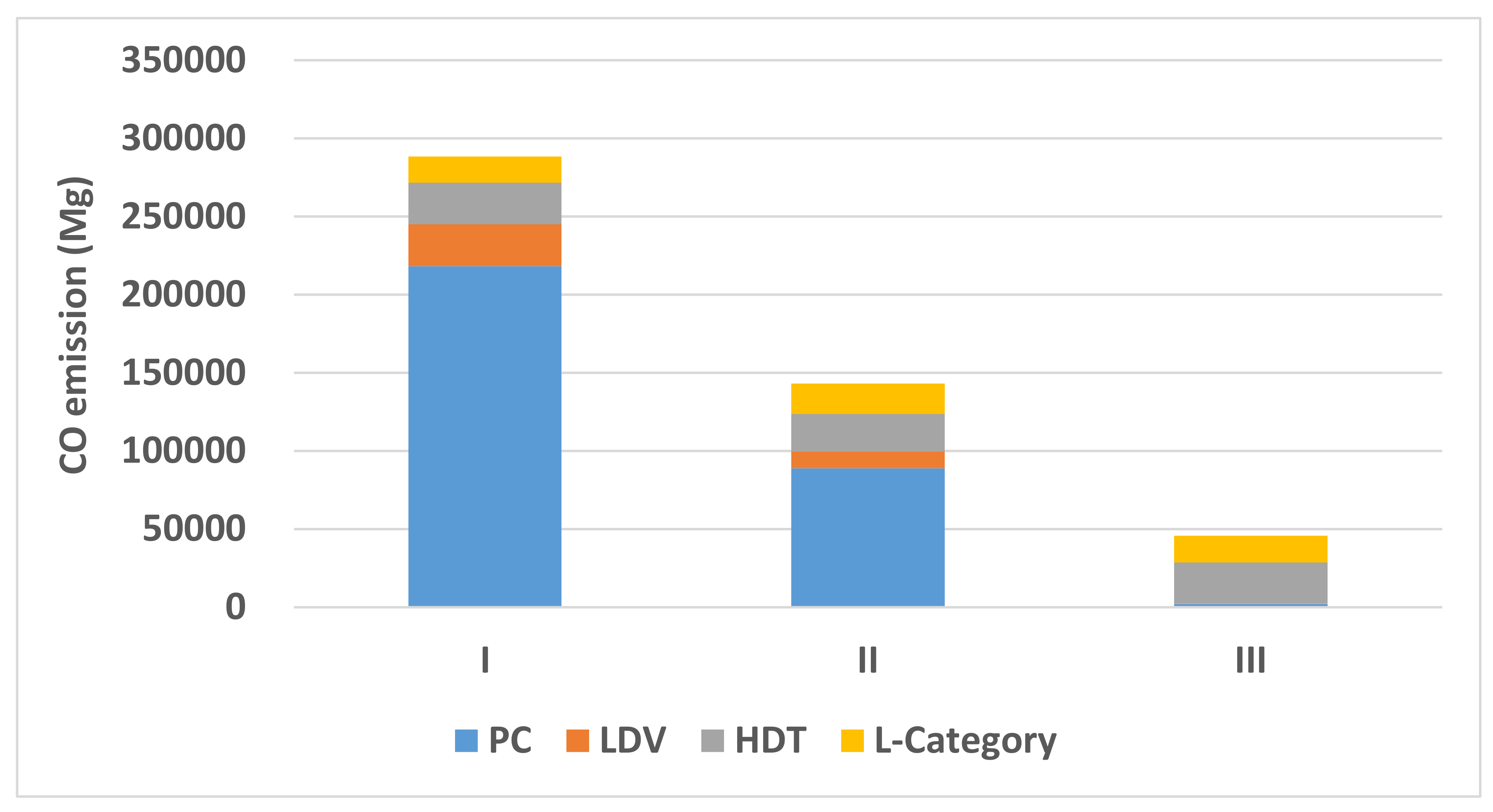
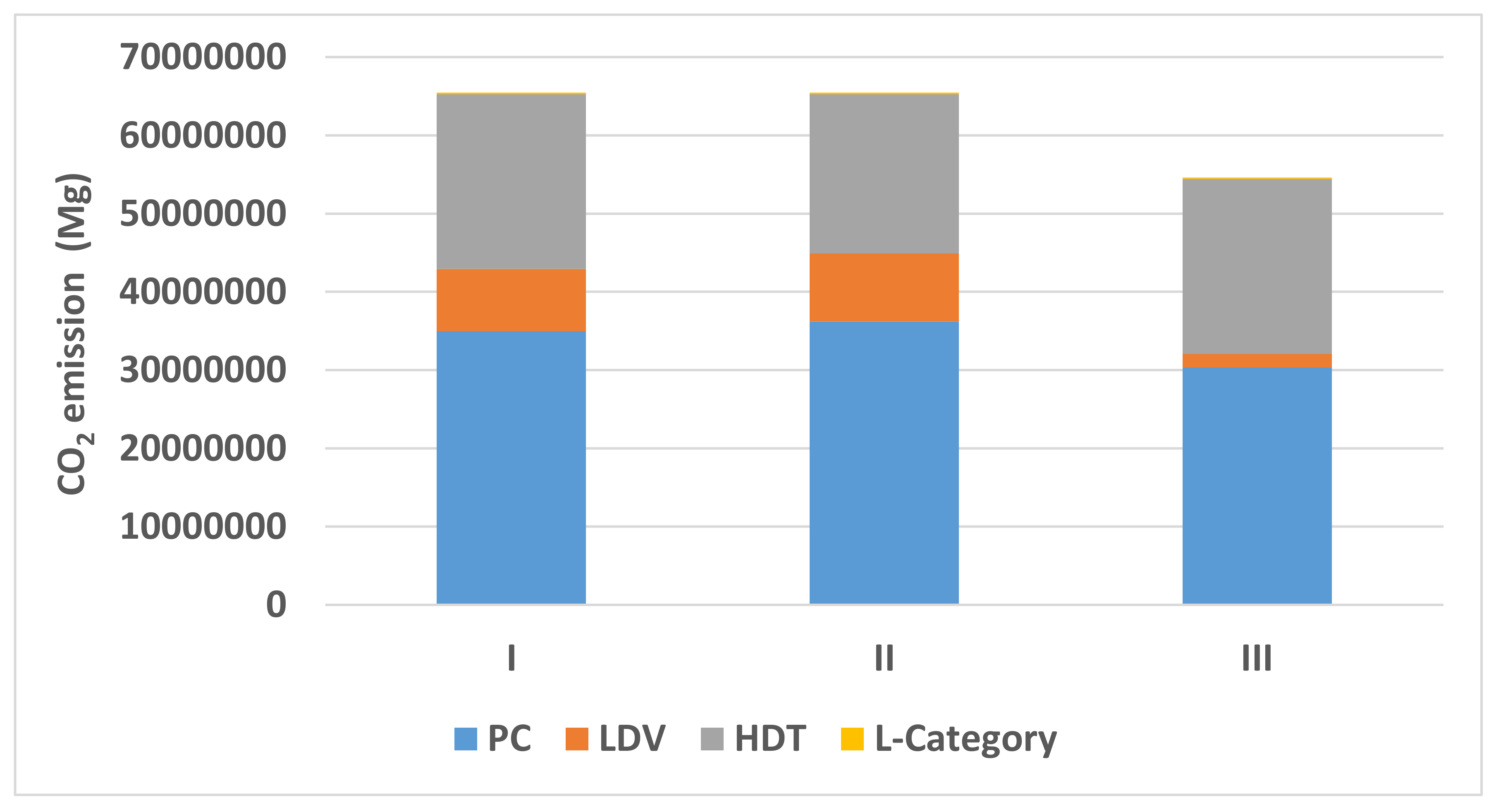
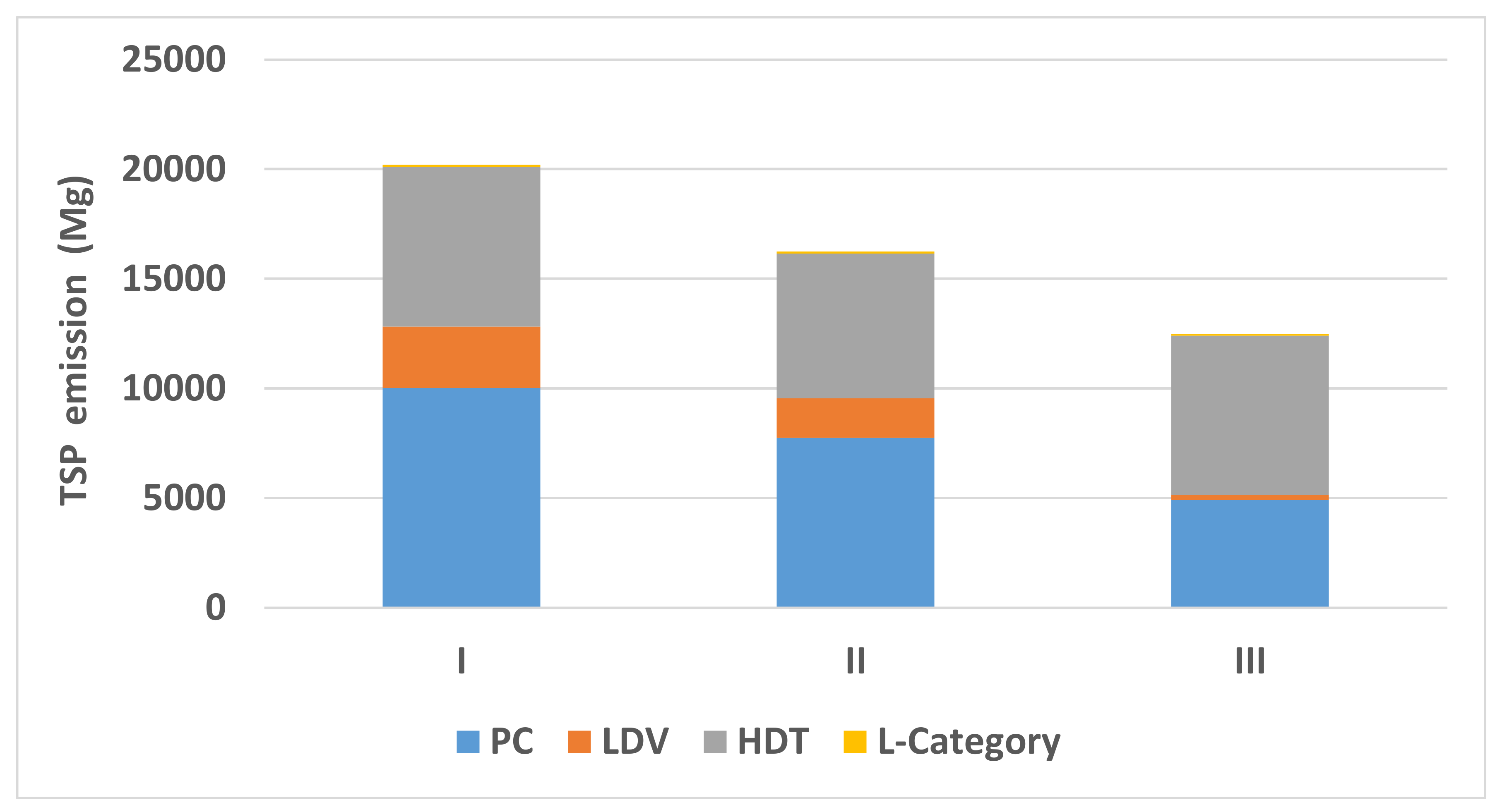
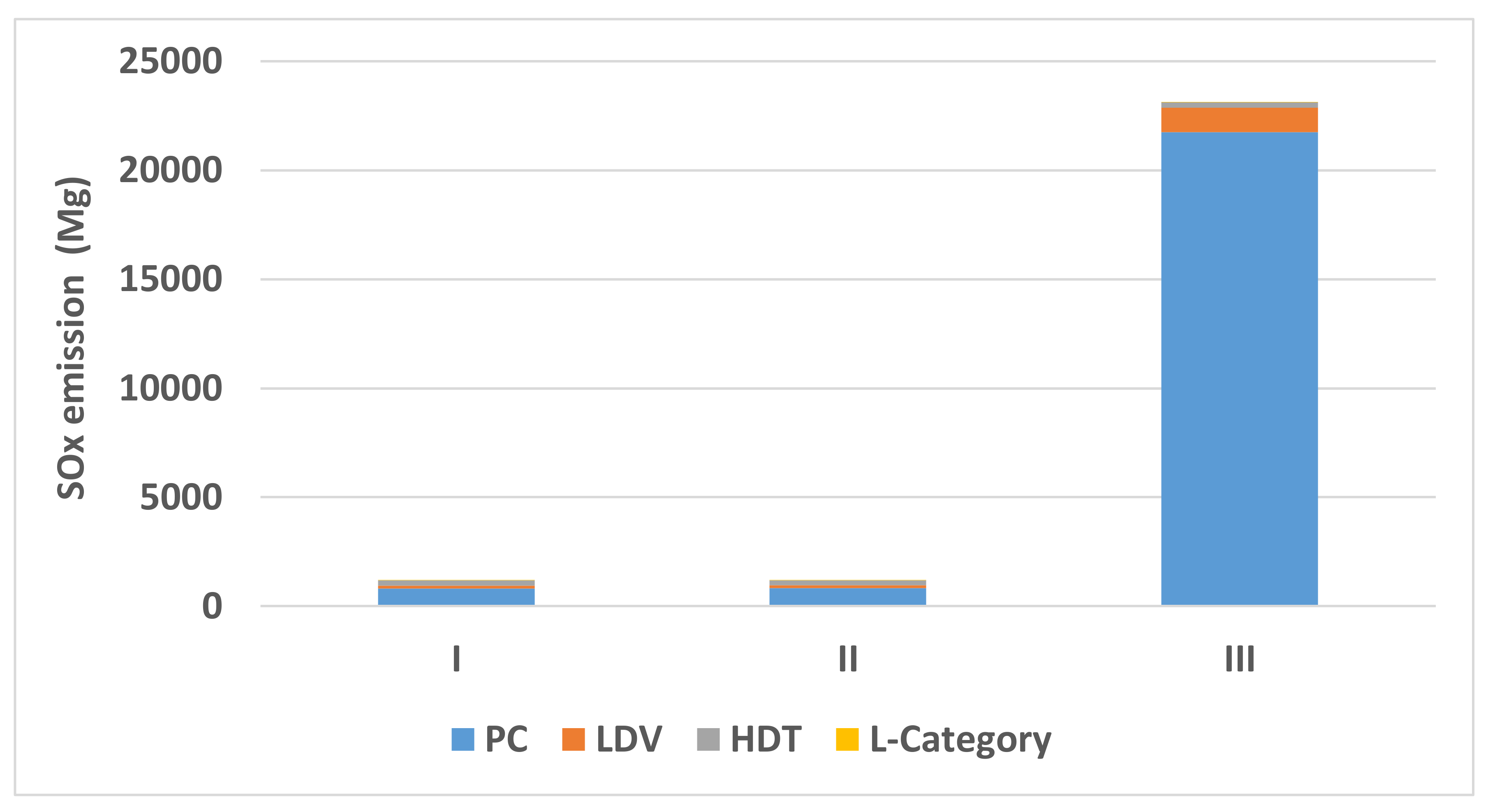
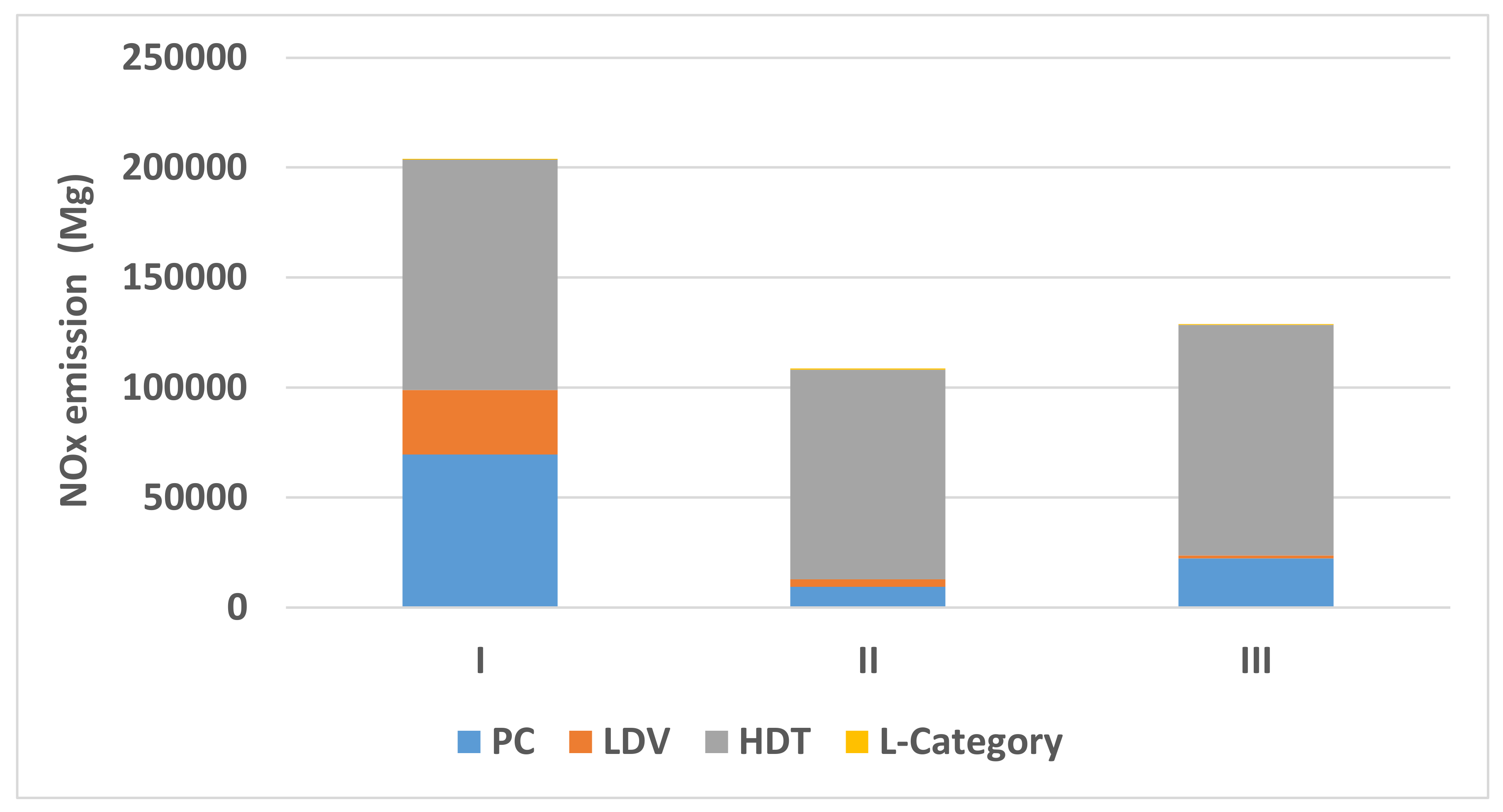
Publisher’s Note: MDPI stays neutral with regard to jurisdictional claims in published maps and institutional affiliations. |
© 2022 by the authors. Licensee MDPI, Basel, Switzerland. This article is an open access article distributed under the terms and conditions of the Creative Commons Attribution (CC BY) license (https://creativecommons.org/licenses/by/4.0/).
Share and Cite
Zimakowska-Laskowska, M.; Laskowski, P. Emission from Internal Combustion Engines and Battery Electric Vehicles: Case Study for Poland. Atmosphere 2022, 13, 401. https://doi.org/10.3390/atmos13030401
Zimakowska-Laskowska M, Laskowski P. Emission from Internal Combustion Engines and Battery Electric Vehicles: Case Study for Poland. Atmosphere. 2022; 13(3):401. https://doi.org/10.3390/atmos13030401
Chicago/Turabian StyleZimakowska-Laskowska, Magdalena, and Piotr Laskowski. 2022. "Emission from Internal Combustion Engines and Battery Electric Vehicles: Case Study for Poland" Atmosphere 13, no. 3: 401. https://doi.org/10.3390/atmos13030401
APA StyleZimakowska-Laskowska, M., & Laskowski, P. (2022). Emission from Internal Combustion Engines and Battery Electric Vehicles: Case Study for Poland. Atmosphere, 13(3), 401. https://doi.org/10.3390/atmos13030401





